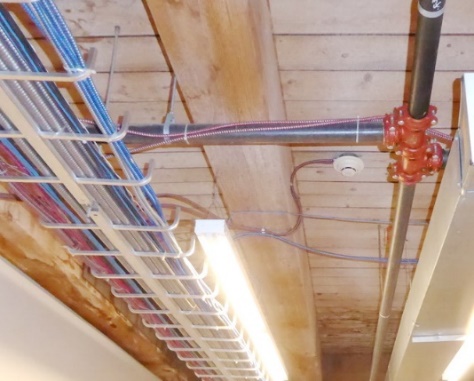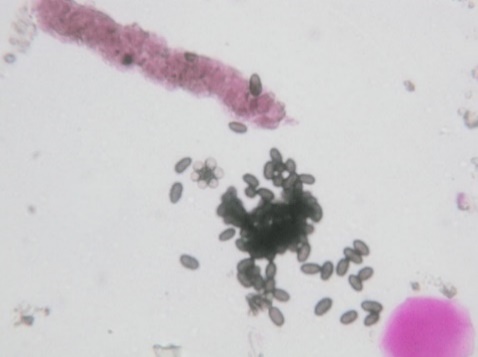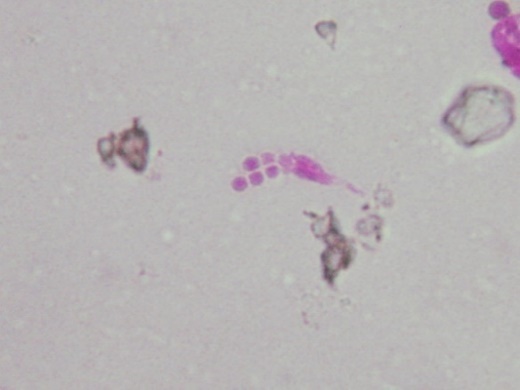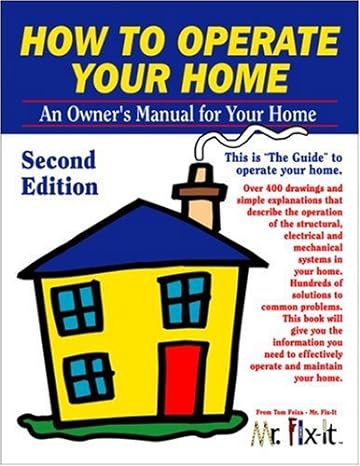IAQ IQ, Winter 2024
©2024 Jeffrey C. May
Many old mill and manufacturing buildings are being adapted for residential and office use. Preserving these beautiful buildings is an outstanding effort but one that should be undertaken with some caution. Here are some of my personal experiences with adaptive reuse.
Fungal rain: Some of these buildings are being transformed into artists’ lofts, with the original high ceilings sandblasted to expose the wood. In one such loft, the client who was renting her unit was referred to me by her physician, because she was suffering from watery eyes, coughing, and respiratory irritation.
The building had been vacant for years and no doubt had suffered from rainwater entry. There were multiple layers of wood flooring at the ceiling. I took a “pat” sample (by gently tapping the wood) of the dust falling from a crack between the ceiling boards. The sample contained many Stachybotrys spores, Penicillium spores, and a Penicillium conidiophore (the spore-forming structure for the mold genus), as well as microarthropod fecal pellets filled with mold spores. That dust could have been aerosolized by building vibrations or pressure changes due to wind or operation of the HVAC system in the unit.
Many microarthropods feed on mold spores, and their fecal pellets are filled with partially digested spores; these fecal pellets are a significant cause of “dust allergy.”
The woman ultimately became hypersensitive to mold and moved out but found great difficulty in locating a new home that did not affect her recently acquired allergies.



Tip for home inspectors:
- Exposed ceiling framing in an old mill building can contain moldy dust.
Suffering Artists: A single-story mill building close to a bay was converted to condominium lofts for artists. Several of the owners were suffering from allergies. All of the furnaces for the condominiums were suspended from the ceiling in a damp crawlspace with a dirt floor. The furnaces had inefficient fiberglass filters with filter holders that were open to the moldy crawlspace. When a furnace was operating, a significant portion of the air came from the crawlspace, because the air was sucked in at the open slot for the filter. I recommended that the filtration be improved and that an airtight filter holder be installed over the filter access.
Tip for home inspectors:
- A furnace located in a dirt basement could entrain moldy dust.
Roof Gas: A family had purchased a top-floor condominium in a mill building converted into residences. Their furnace was in a mechanical closet that was open to the roof framing. After a new membrane roof was installed, they developed headaches from exposure to the VOC fumes from the solvent-based adhesive used to secure the roof membrane. The furnace return was leaky and sucked in the fumes that accumulated in the mechanical room. I recommended that they install an airtight ceiling in the closet and make the return path for the furnace air airtight.
Tip for home inspectors:
- A furnace return should be airtight, and the furnace should not be open to a common ceiling cavity.
Lead Rain: Due to complaints of excessive amounts of dust, I investigated a large first-floor office in a mill building. The wood-plank ceilings had been sandblasted and the office was carpeted. When people walked on the carpet, fine white dust appeared on their shoes. The dust consisted primarily of gypsum from drywall, but a lab confirmed that the dust also contained residues of lead paint that had been blasted from the wood years earlier. (The dust had probably been falling from between the ceiling-plank joints.) I found out later that the company moved out of the building.
Mea Culpa: I was asked by a developer’s representative to check and see if there was any lead paint in a 4-story, long-abandoned mill building with over 40,000 square feet per floor and rain water dripping from some ceilings. The developer was planning to convert the large building into apartments. At the time, lead-paint testing was done using sodium sulfide, a stinky chemical solution that when added to the lead pigment in paint converted the white, lead-carbonate pigment to black, lead sulfide. Since I was educated as an organic chemist, I felt qualified to use the solution that I prepared myself to do some pre-screening experiments. I walked around the empty building with a representative of the developer for about an hour. I checked the paint in a few random locations where I felt that there might be lead paint; some of the white paint in the stairwell turned black indicating the presence of lead.
Given the size and complexity of the building and my $150 dollar fee for the short visit, I handed the dropper bottle with the sodium sulfide solution to the representative and suggested that he do more extensive pre–testing. This all took place before the restrictive Massachusetts lead testing laws were in place. I wrote a one-page letter describing the few places where I had found lead paint but spent much of the letter talking about refinishing the wood.
Years later, a licensed lead-paint inspector I knew accosted me at a meeting and told me that he had done lead paint testing for an apartment tenant in the now-converted mill building. He said that he had seen my “report” and wanted to tell me that there was lead paint in the building that I had missed! In addition, the bank had used my “report” in deciding to provide a mortgage for the project. You can bet that I had a few sleepless nights. (Turned out that the only places lead was found were in some support columns that were easily encapsulated; whew!)
Tips for home inspectors:
We all know that lead paint can be present inside houses or apartment buildings built before 1978, but lead can also be elsewhere:
- In soil around a house that used to be painted with a lead-based product, and the paint was scraped or sanded off.
- In carpeting in such a home, because people could have brought soil into the house on their shoes, and that soil may have contained lead-paint dust.
If you are inspecting an older home and suspect there may have been lead paint on the cladding, recommend that the soil within a few feet of the foundation be tested for lead. If lead is present in the soil, people should not use the soil for growing any edibles or allow children to play in that dirt.
With the exception of the book cover, the photograph and micrographs in this article belong to
May Indoor Air Investigations LLC and can be used only with permission.
978-649-1055 jeff@mayindoorair.com
Happy New Year!
Jeff May

How to Operate Your Home,” written by home inspector Tom Feiza, is a great resource for homeowners and is available on line.
